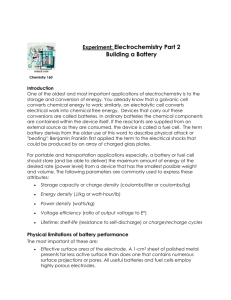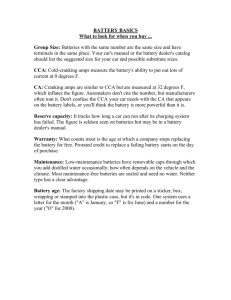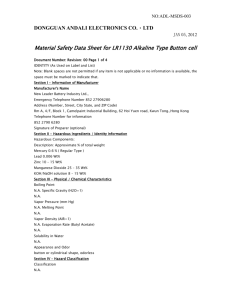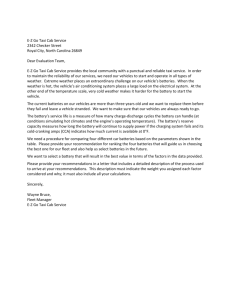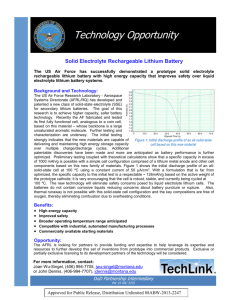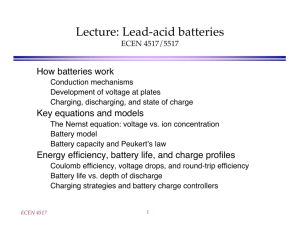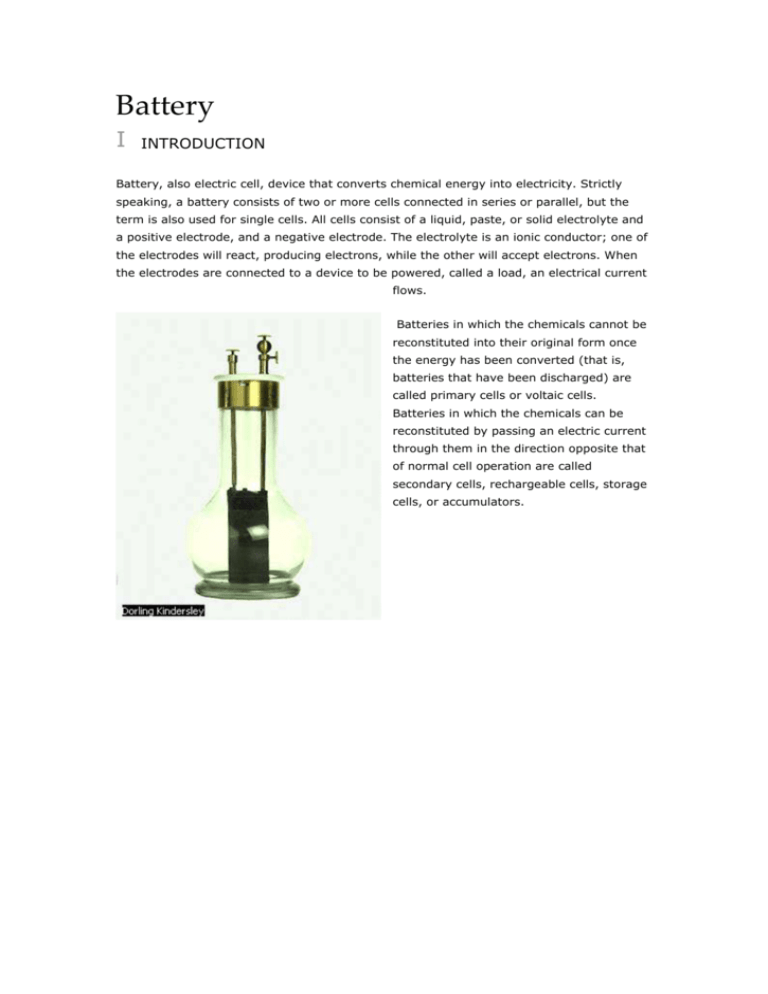
Battery
I
INTRODUCTION
Battery, also electric cell, device that converts chemical energy into electricity. Strictly
speaking, a battery consists of two or more cells connected in series or parallel, but the
term is also used for single cells. All cells consist of a liquid, paste, or solid electrolyte and
a positive electrode, and a negative electrode. The electrolyte is an ionic conductor; one of
the electrodes will react, producing electrons, while the other will accept electrons. When
the electrodes are connected to a device to be powered, called a load, an electrical current
flows.
Batteries in which the chemicals cannot be
reconstituted into their original form once
the energy has been converted (that is,
batteries that have been discharged) are
called primary cells or voltaic cells.
Batteries in which the chemicals can be
reconstituted by passing an electric current
through them in the direction opposite that
of normal cell operation are called
secondary cells, rechargeable cells, storage
cells, or accumulators.
II
PRIMARY CELLS
The most common form of primary cell is the Leclanché cell, invented by the French
chemist Georges Leclanché in the 1860s. It is popularly called a dry cell or flashlight
battery. The Leclanché cell in use today is very similar to the original invention. The
electrolyte consists of a mixture of ammonium chloride and zinc chloride made into a
paste. The negative electrode is made of zinc, as is the outside shell of the cell, and the
positive electrode is a carbon rod surrounded by a mixture of carbon and manganese
dioxide. The Leclanché cell produces about 1.5 V.
Another widely used primary cell is the zinc-mercuric-oxide cell, more commonly called a
mercury battery. It can be made in the shape of a small flat disk and is used in this form in
hearing aids, photoelectric cells, and electric wristwatches. The negative electrode consists
of zinc, the positive electrode is of mercuric oxide, and the electrolyte is a solution of
potassium hydroxide. The mercury battery produces about 1.34 V.
The fuel cell is another type of primary cell. It is unique in that the chemicals are not
contained within the cell but are supplied from outside.
III
SECONDARY CELLS
The storage battery, or secondary cell, which can be recharged by reversing the chemical
reaction, was invented in 1859 by the French physicist Gaston Planté. Planté's cell was a
lead-acid battery, the type widely used today. The lead-acid battery, which consists of
three or six cells connected in series, is used in automobiles, trucks, aircraft, and other
vehicles. Its chief advantage is that it can deliver a strong current of electricity for starting
an engine; however, it runs down quickly. The electrolyte is a dilute solution of sulfuric
acid, the negative electrode consists of lead, and the positive electrode of lead dioxide. In
operation, the negative lead electrode dissociates into free electrons and positive lead ions.
The electrons travel through the external electric circuit, and the positive lead ions
combine with the sulfate ions in the electrolyte to form lead sulfate. When the electrons
reenter the cell at the positive lead-dioxide electrode, another chemical reaction occurs.
The lead dioxide combines with the hydrogen ions in the electrolyte and with the returning
electrons to form water, releasing lead ions in the electrolyte to form additional lead
sulfate.
A lead-acid storage cell runs down as the sulfuric acid gradually is converted into water
and the electrodes are converted into lead sulfate. When the cell is being recharged, the
chemical reactions described above are reversed until the chemicals have been restored to
their original condition. A lead-acid battery has a useful life of about four years. It
produces about 2 V per cell. Recently, lead batteries with useful lives of 50 to 70 years
have been developed for special applications.
Another widely used secondary cell is the alkaline cell, or nickel-iron battery, developed
by the American inventor Thomas Edison in the 1900s. The principle of operation is the
same as in the lead-acid cell except that the negative electrode consists of iron, the
positive electrode is of nickel oxide, and the electrolyte is a solution of potassium
hydroxide. The nickel-iron cell has the disadvantage of giving off hydrogen gas during
charging. This battery is used principally in heavy industry applications. The Edison battery
has a useful life of approximately ten years and produces about 1.15 V.
Another alkaline cell similar to the Edison battery is the nickel-cadmium cell, or cadmium
battery, in which the iron electrode is replaced by one consisting of cadmium. It also
produces about 1.15 V, and its useful lifetime is about 25 years.
A number of new types of batteries have been designed for use in electric vehicles.
Improved versions of conventional storage batteries have been developed for electric cars,
but they still suffer the drawbacks of either short range, high expense, bulkiness, or
environmental problems. Advanced batteries that show promise for use in electric vehicles
include lithium-iron sulfide, zinc-chlorine, nickel metal hydride, and sodium-sulfur. The
U.S. Advanced Battery Consortium (USABC), a consortium that includes the U.S.
Department of Energy and the three major American automakers, was set up in 1991 to
speed development of advanced storage batteries. Such batteries are also being developed
by electric utilities to be used for “load leveling,” to compensate for momentary system
load fluctuations. Such battery modules could be installed close to sites of variable
demand. They cause few environmental problems and occupy little space.
IV
SOLAR BATTERY
Solar batteries produce electricity by a photoelectric conversion process. The source of
electricity is a photosensitive semiconducting substance such as a silicon crystal to which
impurities have been added. When the crystal is struck by light, electrons are dislodged
from the surface of the crystal and migrate toward the opposite surface. There they are
collected as a current of electricity. Solar batteries have very long lifetimes and are used
chiefly in spacecraft as a source of electricity to operate the equipment aboard.
Microsoft ® Encarta ® Reference Library 2004. © 1993-2003 Microsoft Corporation. All
rights reserved.



